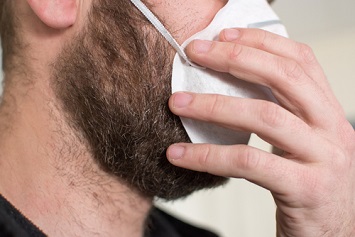Facial hair prevents employees from effectively wearing tight-fitting respirators. Experts at Safety.BLR.com® were recently asked who bears the responsibility for paying for alternate options, such as a Powered Air-Purifying Respirator (PAPR). There are both safety and human resources considerations—read on to see the answer.
Editor’s Note: There are a lot of questions lately about facial hair and its effect on proper respirator use as it relates to the COVID-19 pandemic. While the Centers for Disease Control and Prevention (CDC) recommends against certain facial hair stylings for workers who wear tight-fitting respirators, it has not recommended shaving as a precaution to prevent COVID-19. You can read all of our coverage specific to COVID-19, including mandating facemasks and a running tally of cases in the U.S., at this link.
Q: For an employee with facial hair that prevents them from wearing a tight fitting respirator, is it their or their employer’s responsibility to pay for a loose fitting respirator such as a PAPR?
An employer may be required to provide and pay for a loose-fitting respirator such as a PAPR if an employee’s facial hair prevents him from wearing a tight-fitting respirator. However, there are several safety- and human resources-related considerations.
OSHA requires employers to provide PPE, including respiratory devices, whenever necessary to protect employees against workplace hazards capable of causing injury or impairment. PPE must be provided by the employer at no cost to employees unless it is one of the specific types listed in 29 CFR 1910.132(h)(2) through 1910.132(h)(4)(iii).
Pursuant to the respiratory protection standard, an employer must provide a respirator to each employee when such equipment is necessary to protect the health of such employee. Employers must provide respirators that are applicable and suitable for the purpose intended and must establish and maintain a respiratory protection program.
However, OSHA does not specify in the respiratory protection standard the type of respirator that must be provided (though it does set forth the criteria that must be considered for selection). Further, the standard does not require the employer to provide a specific respirator upon employee request. Additionally, the standard does not require the employer to provide a more protective respirator if its use is not warranted by the hazardous exposure.
As you correctly note, an employer may not allow respirators with tight-fitting facepieces to be worn by employees who have facial hair that comes between the sealing surface of the facepiece and the face or that interferes with valve function. To adequately protect the employee from the workplace hazard, your options would be to provide the employee with a suitable loose-fitting respirator at no cost to him, to remove him from duties requiring the use of a respirator, or to implement a clear policy as to shaving/facial hair as part of your written respiratory protection program.
If you choose one of the latter two approaches, keep in mind that other human resources-related legal requirements could be implicated, particularly if the employee has grown a beard for religious reasons. For example, Title VII of the Civil Rights Act prohibits discrimination based on “religion,” which is defined as including “all aspects of religious observance and practice, as well as belief, unless an employer demonstrates that he is unable to reasonably accommodate to an employee’s or prospective employee’s religious observance or practice without under hardship on the conduct of the employer’s business.
For further guidance on this matter, see the OSHA Letters of Interpretation dated April 16, 1996; March 7, 2003; and May 9, 2016.
This question was answered by experts at Safety.BLR.com. If you would like to take a free trial of this valuable safety resource, click here.

